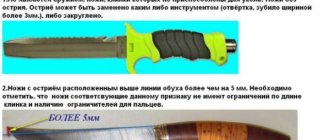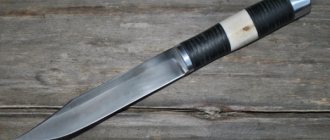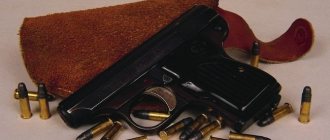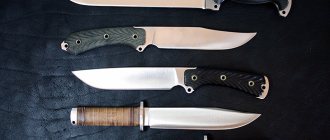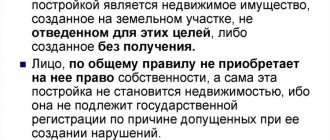Let's find out what is possible and what is not possible when carrying and storing knives from the point of view of Russian legislation, especially since in recent years there have been quite a lot of changes in this area.
Simplified in Russia, knives are divided into two categories, these are:
- knives that are not edged weapons;
- knives that are edged weapons.
In the photo, the knives are either edged weapons or not.
Almost all knives that we use in everyday life fall into the category of knives that are not edged weapons.
These are kitchen, table, and folding knives. This also includes fixed blade knives that are used by tourists and hunters for various purposes. But these same knives can also fall into the category of edged weapons.
The category of knives, which is a bladed weapon, is a separate category that is quite difficult for an ordinary person to purchase, and impossible in a regular store.
You can legally purchase a knife that is a bladed weapon in the Russian Federation in the following way:
- go to military service in the army or some state paramilitary structure;
- become a hunter, or simply issue a hunting license and obtain permission to store and carry smooth-bore or rifled hunting weapons;
- be a representative of national minorities who are allowed to carry bladed weapons with their national costume;
- become a collector and obtain a permit to store collectible edged weapons.
Theoretically, you can make a knife that is a bladed weapon yourself or order it from some blacksmith, but then you will fall under Articles 222 and 223 of the Criminal Code of the Russian Federation.
What is considered a bladed weapon?
The Federal Law “On Weapons” provides a definition of this concept. A bladed weapon is an object designed to hit a living target using human muscular strength in contact with the victim of the attack. These are knives, daggers, brass knuckles, sabers.
There are several groups of edged weapons:
- piercing;
- chopping;
- piercing-cutting;
- piercing-cutting;
- impact-crushing;
- throwing;
- combined action: karambit, shuangou.
The following characteristics are characteristic of edged weapons:
You are advised by the best qualified lawyers
Free: Our lawyers provide free initial consultation on any legal issues. 90% of cases are resolved with one free consultation.
24/7: real estate via online chat, or call the hotline 24 hours a day, 7 days a week
- blade length is more than 90 mm;
- blade thicker than 2.4 mm;
- the angle of convergence of the butt and blade is less than 70 degrees;
- blade roll no more than 9 mm;
- minimum steel hardness - 25 Rockwell;
- the blade can penetrate to a depth of more than 20 mm;
- the holder has a finger stop;
- the tip of the blade should be comfortable for striking if the weapon has a stopper.
Only an expert can give an opinion on whether a certain item is a bladed weapon. Experts do not consider weapons that are intended for use in everyday life - garden knives, kitchen knives, manicure scissors.
Knife: storage, carrying, transportation.
The most frequently asked questions regarding carrying knives boil down to the following: Is a knife in the car worth carrying? What is the length of the knife blade so that I don’t have any questions? What kind of knife is a bladed weapon? What will happen to me if I travel on the subway with a tourist knife with a blade length of 11 cm? What if 7 cm? This article answers these questions with reference to current legislation.
So what do we have? (I’ll make a reservation right away that the article was written for those who DO NOT have permission) From the regulatory framework we have the following documents:
Federal Law of December 13, 1996 N 150-FZ (as amended on July 26, 2019) “On Weapons”
Order of the Ministry of Internal Affairs of Russia dated June 30, 2017 N 429 “On approval of forensic requirements for the technical characteristics of civilian and service weapons, as well as cartridges for them” (Registered with the Ministry of Justice of Russia on September 15, 2017 N 48193)
"GOST R 51215-98. State standard of the Russian Federation. The weapon is cold. Terms and definitions" (adopted and put into effect by Resolution of the State Standard of Russia dated December 17, 1998 N 401)
Criminal Code Art. 222 and 223
Code of Administrative Offenses Article 20.8
Resolution of the Plenum of the Supreme Court of the Russian Federation dated March 12, 2002 N 5 (as amended on June 11, 2019) “On judicial practice in cases of theft, extortion and illegal trafficking of weapons, ammunition, explosives and explosive devices”
First, let's immediately understand what storage, carrying and transportation are (this applies to all types of weapons, drugs and other things that are restricted or prohibited for circulation).
storage
- hiding these items in premises, hiding places, as well as in other places that ensure their safety.
wearing
- finding them in the clothes or directly on the body of the perpetrator, as well as carrying them in a bag, briefcase, etc. subjects.
shipping
- travel by any type of transport.
Now we answer the question of what edged weapons are.
These definitions are given in the Federal Law of December 13, 1996 N 150-FZ (as amended on July 26, 2019) “On Weapons”, in paragraph. 4 tbsp. 1 (a weapon designed to hit a target using human muscular power in direct contact with the target) and in Resolution of the Plenum of the Supreme Court of the Russian Federation dated March 12, 2002 N 5 (as amended on June 11, 2019) “On judicial practice in cases of theft, extortion and illicit trafficking in weapons, ammunition, explosives and explosive devices”, paragraph 6 (industrially or home-made objects intended to destroy a target using human muscular power in direct contact with the target, which include edged bladed weapons ( daggers; combat, national, hunting knives that are weapons; bayonet-knives; sabers; checkers; swords, etc.), other weapons of cutting, piercing, chopping or mixed action (bayonets, spears, battle axes, etc. ), as well as impact-crushing weapons (brass knuckles, nunchucks, flails, etc.).
As we can see from the above definitions, no technical characteristics of edged weapons are given in the definitions. According to the dispositive principle of legal regulation, everything that is not prohibited by law is permitted. Now let's turn to what is prohibited by law.
Reading the provisions of Articles 222 and 223 of the Criminal Code of the Russian Federation, we find the following.
According to paragraph 4 of Article 222 of the Criminal Code of the Russian Federation, the illegal sale of bladed weapons is a criminal offense; according to paragraph 4 of Article 223 of the Criminal Code of the Russian Federation, the illegal manufacture of bladed weapons is a criminal offense, which means that carrying, storing and transporting bladed weapons constitutes a crime does not form.
We read the provisions of Art. 20.8 of the Code of Administrative Offenses of the Russian Federation and draw the following conclusions:
Clause 4 of this article concerns citizens directly in terms of carrying and storing weapons - within the meaning of this provision of the law, this includes all types of weapons, including cold steel.
transportation of bladed weapons (being in a vehicle) does not constitute an administrative offense.
the objective side of the offense provided for in paragraph 4 of Art. 20.8 of the Administrative Code constitutes a violation of the RULES, which are the rules established by Art. 22 and 25 Federal Law “On Weapons”. In other words, for carrying and storing bladed weapons against the rules (illegal), administrative liability arises as provided for in paragraph 4 of Article 20.8 of the Code of Administrative Offenses of the Russian Federation + confiscation of the controversial item.
In accordance with the Decree of the Government of the Russian Federation dated December 1, 2009 N 982 (as amended on February 21, 2018) “On approval of a unified list of products subject to mandatory certification and a unified list of products, confirmation of conformity of which is carried out in the form of a declaration of conformity” (as amended . and additional, entered into force on December 27, 2018) a unified list of products subject to mandatory certification was approved. Thus, the following are subject to mandatory certification:
Products structurally similar to bladed weapons:
tourist and special sports knives
cutting and skinning knives
Decorative and souvenir products similar in external structure to bladed or throwing weapons
Equipment for applied sports (bows, sabers, swords)
Accessories for sport hunting, sports and recreational fishing (knives)
In this connection, it is necessary to purchase a similar product in stores that have an accreditation certificate and can issue you a test report for a product that is structurally similar to edged weapons. This certificate of conformity will guarantee that the knife you have with you is not a bladed weapon.
Anyone interested can check it out
"GOST R 51215-98. State standard of the Russian Federation. The weapon is cold. Terms and definitions" (adopted and put into effect by Resolution of the State Standard of Russia dated December 17, 1998 N 401)
"GOST R 51715-2001. State standard of the Russian Federation. Decorative and souvenir products, similar in external structure to bladed or throwing weapons. General technical requirements" (adopted and put into effect by Resolution of the State Standard of Russia dated 02/21/2001 N 79-st) (as amended on 04/18/2005)
and understand in detail the terminology associated with edged weapons.
What could happen if your knife appears “suspicious” to the police?
He will be sent for forensic examination. The examination of bladed weapons is carried out in order to establish whether an item belongs to a bladed weapon, to determine whether it belongs to a certain type, type, or method of manufacture. This type of examination is carried out in almost all state and non-state expert institutions and by private experts.
The main diagnostic questions are as follows.
1. Is this item a melee weapon?
2. What type, type and model of edged weapons does this item belong to?
3. How were these bladed weapons made: factory-made, homemade or home-made?
4. Is this item a blank of a bladed weapon?
5. What materials, tools, equipment, devices were used in the manufacture of this bladed weapon? Is this bladed weapon converted from another bladed weapon or other item (what)?
6. Is this bladed weapon in good working order? If not, can it be brought back into working order?
Another group of questions is of an identification nature.
In order to understand what the expert will be guided by during the examination, let us turn to the following document:
Order of the Ministry of Internal Affairs of Russia dated June 30, 2017 N 429 “On approval of forensic requirements for the technical characteristics of civilian and service weapons, as well as cartridges for them” (Registered with the Ministry of Justice of Russia on September 15, 2017 N 48193)
Hunting bladed weapons include knives, daggers and hunting cutlasses. Hunting knives, daggers and cutlasses are structurally designed to kill animals while hunting using human muscular strength and must consist of a blade and a safety handle:
Technical characteristics of hunting knife blades:
blade length more than 90 mm;
butt thickness more than 2.6 mm;
tip angle no more than 70°;
blade hardness of at least 42 units on the Rockwell scale;
For hunting knives, additional sharpening is allowed on the bevel and part of the butt for a length of up to 1/3 of the blade (from its tip).
Technical characteristics of hunting daggers:
hunting daggers are awkward in design (collapsible and non-collapsible);
blade length not less than 150 mm;
thickness not less than 4.0 mm;
blade width is at least 25 mm;
the ratio of the length of the blade to its width is no more than 6:1;
tip angle no more than 70°;
blade hardness of at least 42 units on the Rockwell scale;
On the blades of hunting daggers, it is allowed to have a one-sided or double-sided heel with a length of no more than 1/3 of the blade.
Technical characteristics of hunting cutlasses:
blade length from 210 to 500 mm;
butt thickness is at least 3.0 mm;
blade width from 25 to 45 mm;
tip angle no more than 70°;
blade hardness of at least 40 units on the Rockwell scale;
The sharpening width of a blade that is not rhombic or wedge-shaped directly at the tip is more than 20 mm.
The handle of hunting knives, daggers and cutlasses must be injury-proof and meet the following parameters:
the width of the one-sided or two-sided (in total) limiter exceeds the width of the handle by more than 5 mm;
the depth of a single finger groove on the front bushing or handle shaft is more than 5 mm;
the depth of the finger grooves on the handle shaft, which has more than one finger groove, is more than 4 mm;
the thickness of the heel of the blade, used as a stop or finger groove, is more than 3.5 mm;
the difference between the maximum diameter in the middle part of the barrel-shaped handle and the minimum diameter in the pommel area is more than 8 mm;
the difference between the maximum diameter of the stopper and the minimum diameter in the pommel area of a wedge-shaped handle is more than 8 mm;
handle length is more than 70 mm.
If what is confiscated from you meets these requirements, then you were carrying an item restricted for circulation, it will be confiscated from you, and you will be held administratively liable.
To answer the question about traveling on public transport and the metro with objects that structurally resemble bladed weapons, you should familiarize yourself with the rules established by the carrier. So, for example, travel in the St. Petersburg metro with even a penknife with a blade length exceeding 50 mm is prohibited; you may be denied travel in the metro if this item is found on you.
The situation is similar when visiting certain objects, such as courts. At the entrance to the court you will be asked to give your knife for safekeeping. They won't let him into the courthouse.
So, whoever considers it necessary can freely carry with them an object that is structurally similar to a bladed weapon and has a certificate of conformity, if only for the good.
Rules for carrying edged weapons
In Russia, the following categories of persons are allowed to carry edged weapons:
- professional athletes, if it is related to the sport;
- hunters, reindeer herders, rangers;
- law enforcement officers, if they are on duty;
- military personnel can carry not only service weapons, but also award/trophy weapons if they have documents with them;
- forwarding security guards who transport or protect inventory items;
- employees of the Russian Academy of Sciences for certain work and research;
- collectors - professional antique dealers.
Note!
Ordinary citizens can also carry bladed weapons, but to do this they need to obtain a special license.
It is also allowed to buy blades and sabers if they complement the national costume. You can only carry such a weapon during a concert, award ceremony, or national costume parade.
What weapons cannot be used in Russia?
The Criminal Code of the Russian Federation stipulates in detail which chemical weapons are prohibited from being carried on the territory of Russia. Such accessories cannot be used not only as civilian weapons, but also as service weapons.
In particular, we are talking about products:
- Blade-type weapons whose blade length exceeds 90 mm.
- Products in which the blade is removed from the handle by automatic ejection after pressing the button. After extension, the blade is securely fixed.
- The blade extends using accelerated movement or gravity, after which it locks automatically.
Possession and use of such weapons may be regarded as non-compliance with the rules and regulations for handling bladed weapons, which means that the owner may be prosecuted.
License to carry weapons
Permission to purchase and carry weapons is obtained from the licensing department of the Ministry of Internal Affairs at the place of residence. To do this, you need to prepare the following documents:
- statement;
- passport with copies;
- medical certificate that the citizen is allowed to use weapons;
- two 3x4 photographs;
- check for payment of state duty - 350 rubles.
Persons over 18 years of age who have Russian citizenship can obtain a weapons license. A sample application can be obtained from the licensing department of the OLRR or on the State Services website (https://www.gosuslugi.ru/106396/2).
The license validity period is 5 years.
Illegal carrying of weapons
The law prohibits carrying bladed weapons unless the owner has a license to do so.
The permit will not be issued if:
- the applicant is under 18 years of age;
- the person does not have a medical certificate allowing him to carry a weapon;
- the person has an outstanding criminal record;
- the citizen was brought to administrative responsibility more than twice a year;
- the applicant does not have a permanent place of residence;
- the citizen received punishment for using or distributing drugs;
- the court prohibited the citizen from keeping any weapons.
Responsibility for carrying bladed weapons
For illegal carrying of weapons, you can incur administrative liability under Article 20.8 of the Code of Administrative Offenses of the Russian Federation. The violator is given a fine of 500 to 2,000 rubles or is deprived of the right to purchase and store weapons for a year.
There will be criminal liability for the sale of bladed weapons. According to Article 222 of the Criminal Code of the Russian Federation, a violator may receive:
- up to 480 hours of compulsory work;
- 1-2 years of correctional labor;
- up to 2 years of forced labor;
- up to 2 years of restriction of freedom;
- 3-6 months of arrest;
- 2 years of imprisonment and a fine of 80,000 rubles or in the amount of the defendant’s income for six months.
Typology
It is a license issued by the Internal Affairs Authority at the place of residence. There is an established opinion regarding the correct transportation of products in this category. And many police officers adhere to it. Thus, it is considered correct to carry bladed weapons along with accompanying documents in a bag or backpack. At the same time, of course, when detained by police, one can try to explain that the knife in the case on the belt is not a means of self-defense and is hanging solely for convenience. Moreover, the law does not stipulate where exactly it should be kept during transportation. Of course, you should have the relevant documents with you. Otherwise, it will be difficult to prove anything.
Transportation procedure
In the 70s of the previous century, ordinary citizens were forced to look for means to ensure their safety while on city streets. This was due to a sharp increase in crime. Over the next decade, the volume of manufactured bladed weapons for concealed carry increased significantly. Initially, manufacturers took as a basis the developments of the above USS and USO. Subsequent improvements in the designs of bladed weapons for concealed carry followed the development and implementation of new devices, reducing the size of the blade itself while simultaneously increasing its cutting or piercing properties. Products disguised as ordinary objects were also produced.
More to read —> Is it possible to return 13 percent from the purchase of an apartment if the apartment was purchased after dismissal for health reasons
Currently, in order to obtain a license to store and carry bladed weapons, you do not need to be a superman. You just need to come to the government agency that has the right to issue such permits, write an application, pay a small state fee of no more than two thousand rubles and undergo a short medical examination. Then wait a little time and get the finished paper in your hands. With it, a person will not receive any punishment and will own bladed weapons legally. Therefore, you should not risk your money, time, and maybe even freedom, but you should do everything according to the law and obtain the appropriate permission, and then purchase the edged weapon you like.
In this article you learned about carrying knives. If you have any questions or problems that require the participation of lawyers, then you can seek help from the specialists of the Sherlock information and legal portal. Just leave a request on our website and our lawyers will call you back.
What is not considered a bladed weapon?
Criminal liability awaits those who illegally sell bladed weapons. The Criminal Code of the Russian Federation, and in particular Article 222, part four, states that for the sale of edged weapons, any person will be punished in the form of:
According to GOST, a sharpened knife should cut a birch branch with a thickness of 10-12 mm with a humidity of about 12% 5-6 times, leaving a smooth, burr-free cut. Law enforcement agencies tend to define sharpening of a knife as simply removing the cutting edge.
Rules for storing weapons
When purchasing edged weapons, you must provide permission to store them. Without a license, a store employee has no right to sell weapons. In turn, the seller must provide documents for the goods after purchase, so that problems with the law do not arise in the future.
Note!
Since the license is valid for 5 years, upon expiration it must be changed or renewed. The law prohibits the purchase or possession of weapons if the license has expired.
Any weapon at home should be stored in a metal safe. Only the owner should have access to the safe.
It is prohibited to carry bladed weapons for self-defense, as well as during rallies, processions and demonstrations. You cannot send bladed weapons by mail. Athletes may use weapons within the sporting venue. A fencer may only use an epee during training or competition. Military and law enforcement officers are allowed to carry weapons only while on duty.
